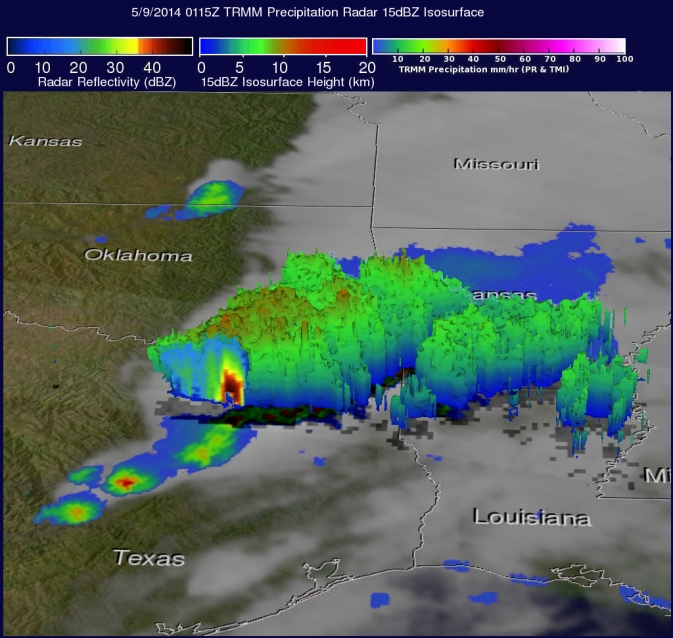NASA's TRMM Satellite See Spring Storms Hit the U.S. Great Plains

The TRMM satellite flew above tornado spawning thunderstorms in the southern United States on May 9, 2014 at 0115 UTC. Image Credit: SSAI/NASA, Hal Pierce
Severe weather extended from Minnesota to southern Texas on Thursday afternoon, May 8 and Friday morning, May 9. During that time there were three tornadoes reported in Minnesota, two in Colorado and two in Missouri.
The TRMM satellite flew above tornado spawning thunderstorms in the southern United States on May 9, 2014 at 0115 UTC (May 8, 2014 at 8:15 PM CTD).
A rainfall analysis from TRMM's Precipitation Radar (PR) and Microwave Imager (TMI) was created at NASA's Goddard Space Flight Center in Greenbelt, Md.
The TRMM data was overlaid on an infrared image from NOAA's GOES-East satellite that showed the extent of the clouds at the same time.
TRMM's PR instrument found rain falling at a rate of over almost 163 mm (about 6.4 inches) per hour in an intense line of storms extending from Arkansas into Texas.
TRMM noticed that some of the highest thunderstorms topped out at around 11 km (6.8 miles) high. Some of these powerful storms were returning reflectivity values of over 55dBZ to the satellite.
For updated conditions, please visit NOAA's National Weather Service Severe Storm Prediction Center website: http://www.spc.ncep.noaa.gov/
Hal Pierce
NASA's Goddard Space Flight Center
Media Contact
All latest news from the category: Earth Sciences
Earth Sciences (also referred to as Geosciences), which deals with basic issues surrounding our planet, plays a vital role in the area of energy and raw materials supply.
Earth Sciences comprises subjects such as geology, geography, geological informatics, paleontology, mineralogy, petrography, crystallography, geophysics, geodesy, glaciology, cartography, photogrammetry, meteorology and seismology, early-warning systems, earthquake research and polar research.
Newest articles

Sea slugs inspire highly stretchable biomedical sensor
USC Viterbi School of Engineering researcher Hangbo Zhao presents findings on highly stretchable and customizable microneedles for application in fields including neuroscience, tissue engineering, and wearable bioelectronics. The revolution in…

Twisting and binding matter waves with photons in a cavity
Precisely measuring the energy states of individual atoms has been a historical challenge for physicists due to atomic recoil. When an atom interacts with a photon, the atom “recoils” in…

Nanotubes, nanoparticles, and antibodies detect tiny amounts of fentanyl
New sensor is six orders of magnitude more sensitive than the next best thing. A research team at Pitt led by Alexander Star, a chemistry professor in the Kenneth P. Dietrich…





















